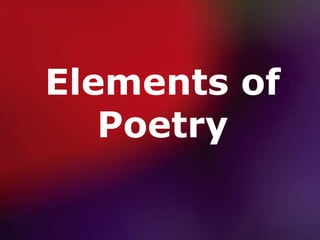
Elements of poetry
- 2. 2 The Speaker and The Poet • Poets will often assumes a role or imitate the speech of a person in a particular situation. • This “role” is referred to as the speaker, voice, mask, or persona. • The voice speaking a poem may sound like it is the poet’s own, and it may be difficult to separate the two, but there is usually a distinction.
- 3. Diction and Tone • Diction refers to the words and grammatical constructions that the poet uses in the creation of their persona. • These choices may occur on a subconscious level. • These choices give the reader insight into the persona of the poet. 3
- 4. Diction and Tone • Speakers have attitudes toward themselves, their subjects, and their audiences. • They choose their words, pitch, and modulation based on these attitudes. • These choices add up to the tone of the poem. • To find the tone, it is a good idea to read the poem aloud. – The reader must try to catch “the speaking tone of voice somehow entangled in the words and fastened to the page for the ear of the imagination.” (Frost) 4
- 5. Figurative Language • Words have their literal meanings, but they can also be used so that something other than the literal meaning is implied. • Common types of figurative language: – Simile: items from different classes are compared by a connective such as “like,” “as,” “appears,” or “seems.” 5
- 6. Figurative Langaage – Metaphor: Assert the identity, without a connective, of terms that are literally incompatible. – Personification: The attribution of human feelings or characteristics or abstractions to inanimate objects. – Apostrophe: Addressing a person or thing that is not literally listening. 6
- 7. Usage of Figurative Language • Figurative language forces the reader to confront the connotations rather than the denotations of written language. – Connotations: suggestions, associations – Denotations: dictionary definitions • It is said to be different than ordinary language, but many of these expressions, due to repetition have become literal. 7
- 8. Usage of Figurative Language • Good figurative language is usually concrete, condensed, and interesting. • It is not limited to literary writers. It is used by most anyone who is concerned with effective expression. 8
- 9. • Imagery refers to any element of setting or character that takes on a figurative significance. • Much of literary imagery is based on the patterned use of diction, such as word choice. – The types of figurative language discussed previously are examples of these patterns. 9 Imagery and Symbolism
- 10. Imagery and Symbolism • Symbols: Images that are so loaded with significance that it is not simply literal, and it does not simply stand for something else; it is both itself and the something else that it suggests. “The Infinite is made to blend with the Finite, to stand visible, and as it were, attainable there.” – Thomas Carlyle 10
- 11. Imagery and Symbolism • Conventional Symbols: people have agreed to accept them as standing for something other than their literal meanings. – Cross = Christianity – Rose = Love, Romance 11
- 12. Verbal Irony and Paradox • Verbal Irony: The speaker’s words mean more or less the opposite of what they say. – Overstatement (hyperbole) – Understatement • Paradox: the assertion of an apparent contradiction 12
- 13. Poetic Structure • Rhythm: Stresses at regular intervals – Poets vary their rhythm according to their purpose. These choices often contribute to the meaning of the poem. “Rhythm must have meaning. It cannot be merely a careless dash off, with no grip and on real hold on the words and sense, a tumty tum tumty tum tum ta.” – Ezra Pound 13
- 14. • Meter: the pattern of stressed sounds – Foot: basic unit of measurement – End-stopped line concludes with a distinct pause – Run-on line has its sense carried over into the next line with a pause – Meter produces rhythm – a poem with end-stopped lines will have a different meter than one with run-on lines. 14 Poetic Structure
- 15. • Rhyme: the repetition of identical or similar stressed sounds or sounds – While rhythm is a basic element of poetry, rhyme is not. – Rhyme suggests order and may be related to meaning. It brings two words together, implying a relationship that the reader may not have been aware of. 15 Poetic Structure
- 16. 16 Poetic Structure • Blank Verse and Free Verse – Blank verse: unrhymed iambic pentameter – Free verse: rhythmical lines, varying in length, adhering to no fixed metrical pattern, and usually unrhymed. The pattern is often based on repetition and parallel grammatical structure.
